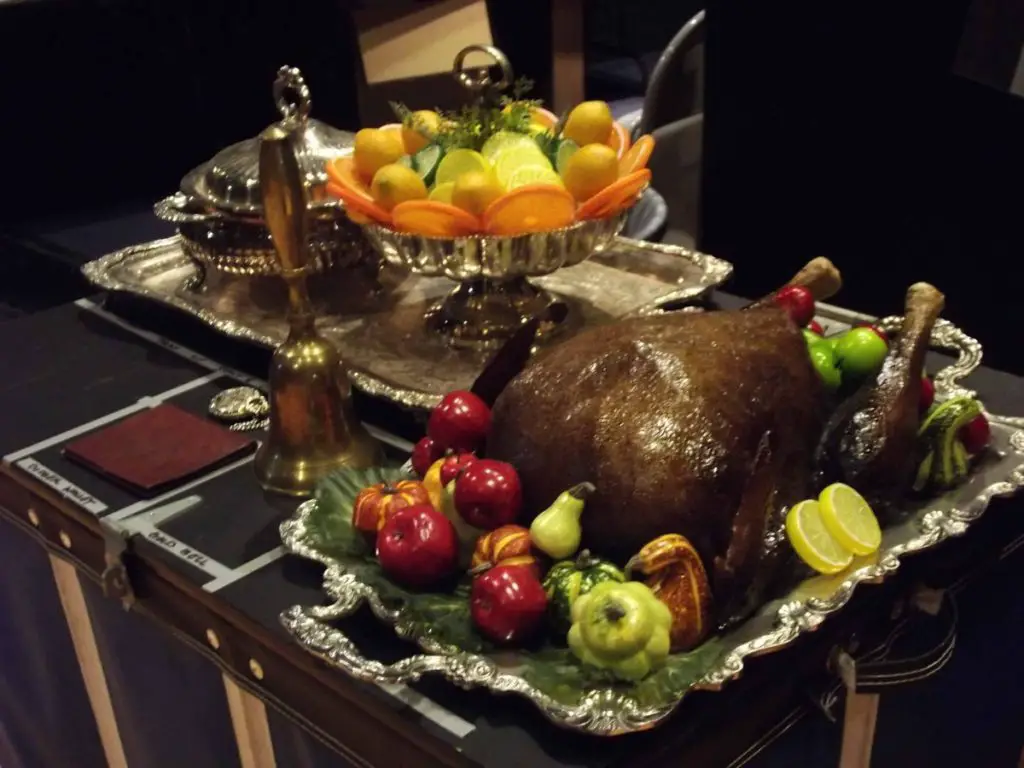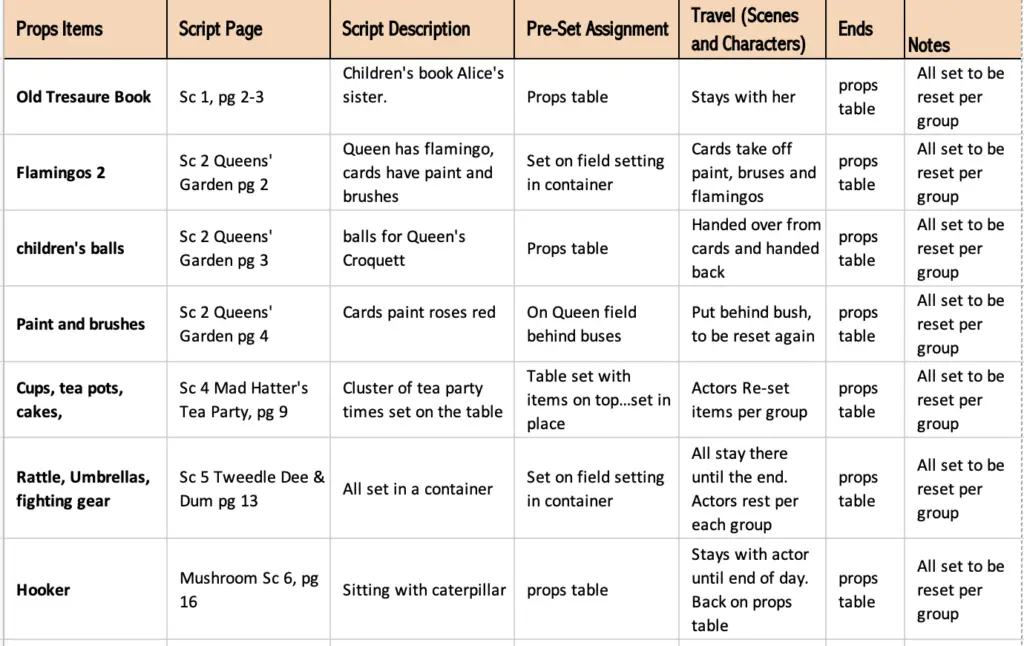Props in the theater are very important. They accentuate the plot and are integral to stage business. Props help anchor an actor to the scene and prevent anticipation of lines. The use of props helps make sense by giving actors appropriate actions that often forward a scene in an authentic portrayal.

Props in The Theater
There are different types of props used in the theater. They are Personal, hand, dressing, large set props to name a few.
Personal Props
The first type are called Persons props. They are the types of props you would use on the body. For instance a man checking the time on his pocket watch or a person taking out a pocket book and pen out and using them. The props are utlizied on the body.
Hand Props
These are props set on the stage for the actors to use. For example, an actor picking up a glass of water to drink.
Hand props allow a female actor to pick up and apply makeup in a dressing room setting. The use of a hairbrush combing the hair helps anchor the actor into the scene.
Or an actor making a cup of coffee. She or he picks up a spoon and scoops up a teaspoon of coffee, drops it into a cup. They then scoop up a teaspoon of sugar and mixes the substances together. She or he slowly bings to the cup to his or her lips and drinks a sip. The subtext is what usually drives the scene on from there. These are probably one of the most used props on stage.
Set Dressings
Often a set would be stylized in a particular way or set in a particular period of time.
The artistic designer or the set designer or set dresser is responsible for the look. Dressings can also be curtains, lights, carpets, rugs, faux grass, plants, statues, basically anything which is seen on the stage which isn’t a personal prop or a set, fixed prop.
History Of Props
The term props are likely to have come from the Greek and Comedia Del Arte troupes which traveled across Europe during the Renaissance periods.
The companies would sometimes have a number of props that were either personal to their character or were part of the ensemble’s collection of properties.
These properties were often knives, combat pieces that could be used by a number of actors. Hence why we have props for short.
Why Are Props Integral For The Actor?
Actors or performers need to use their props as accurately as possible. That means if they are making a drink of coffee, they need to be able to actually make one and find the time to drink it.
This type of prop use is important because it anchors the actor into the scene. The actor can sometimes be distracted as to what their lines are next, but having something authentic to do makes them feel that they are more likely in the scene.
It is Always pertinent for the stage manager to clean the cups and glasses every time they are being used to help prevent sickness in the actors.
Whose Responsibility is It To take care of the props
The props master or mistress is usually the person who is in charge of the props. They should ensure that there is a props table, which has the prop arranged usually in their set places which tape boxing in the props. The tape will often have the character name or actor’s name.
The props master/ mistress usually checks on the props before the actors embark on the stage. But it is also the actor’s job to check that their specific prop I set where it should be set.
There is nothing worse than an actor needing a certain prop within the show which is integral and the prop isn’t set backstage or isn’t onstage.
At times the stage manager, stagehands, or the props master may set a blue light to shine on the props table if there isn’t sufficient light at the back. Blue light is the best kind of lighting at the back because it won’t throw bright yellow light which projects much more than blue.
Protocol for Props Backstage
This stands to reason that you don’t touch other people’s props backstage. No one wants their particular prop to go missing or get damaged. This is especially true when working with beginning actors and children.
Even if you have certain props on the table the best thing is to leave the item until you need it for a scene.
Another no, no is that a lot of actors think the props table is for their personal drink bottles. This can annoy backstage people because they don’t want to risk a drink from the actor spilling on the props or costumes.
It’s best if the actor leaves it off the props table but asks the stage manager for a drinks table. That solves that problem.
Wanting to know more about etiquette for backstage for actors and crew, check out my blog post here. And if you’re interested in etiquette for the technical dress rehearsal, check out my blog post here.
Don’t sabotage The’ Props or Prank Actors
I have been involved when actors started playing practical jokes on each other by sneaking into dressing rooms and putting hot powder in each other’s costumes and props.
I remember one actor getting pepper in his eyes from his mask and this literally hurt his eyes throughout the rest of the scene. As soon as he rushed back stage, he took off his mask and literally was tearing up hugely. It is considered unprofessional to do pranks like this.
This was close to some of the actors coming to blows with each other. Thank goodness the director shut that down immediately with a refocused chat half time.
Often Used Props Utilized For The Theater
Every theater company needs a selection of pros and tools on hand which are the go-to items when needed.
Sometimes these pros and tools are used at every production. At other times they will be needed sporadically or not at all.
Here are a few ideas for essential props and tools you might need for your show.
A starter gun
This gun is usually used by Physical Education teachers. They use them to start a race.
Starter guns are excellent for scenes where someone gets shot. Although depending on the particular gun you may need to have a few sets of caps to go with the gun. Make sure you practice and rehearse using this prop/tool.
Note: the cap might not trigger the gun powder in the gun. The actors may be left high and dry on the stage.
Another way to get the sound of a gunshot is finding a good gunshot sound effect.
Note: make sure the sound technicians get this recorded and that they are briefed in when the noise is cued in.
Knives
You might need a knife in your new production. There are a number of ways to obtain them. You don’t want to use the real deal because the likelihood of someone getting hurt is always an issue.
(Infact one High School play used a real knife plastered up with material. The show was called Sweeney Todd and it called for the barber to cut the throat of another character. Unfortunately the knife penetrated the actor’s neck as he was slicing and he had to go to hospital. Thank goodness he was okay).
You can use fake plastic knives for rehearsal processes. You can Also obtain rubber knives from martial arts stores or clubs themselves. I have personally used these because they are heavily weighted and look the real deal from a distance.
If you’re interested in buying some online, check out this knife I have also bought for shows. It’s made out of rubber and is quite weighty, so the actors will feel as though it has some authenticity. (Amazon affiliate product)
Do check out the other examples on the same page.
Blood
Fake blood is a must for the makeup artist and props kits. Basically you may need it for a backstage touch up for actors.
Related Resources For Becoming a Props Master
Check out this book is: This book explains and provides templates for organizing and managing a prop shop, from pre-production organization to production processes, budgeting, and collaborations with other production areas. It explores how to plan, organize, and maintain a prop shop for safe and efficient production work.
The book interviews two well known props masters who’ve been in the business for years. A fabulous book for all.
It’s a must have for amateur and professional props masters.
Your Freebie Props List Spreadsheet
If you are interested in getting great advice, templates and information on how to budget and mount a production, get the information here from theaterish.com
Make a Google Sheets copy for this Masters Props List. You can also download as an XL Sheet because that’s what it was originally made from.

That’s All Folks
Props are essentials items to most productions unless you are in a mimed show. They have their importance and are integral depending on the scene and direction of the director. There are protocols to source, utilize and look after props.
If you liked this article please consider signing to receive future articles. Check out here for other articles on: